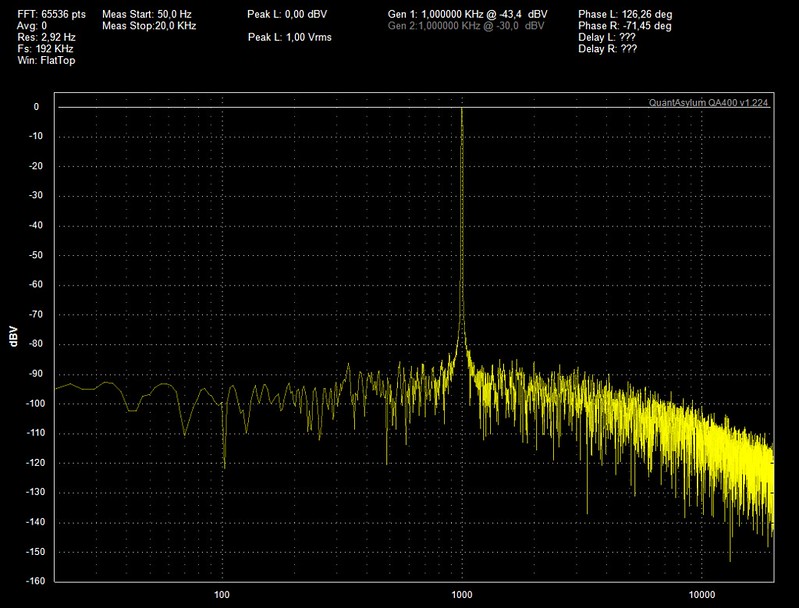The previous measurements have mistakenly been at 36 dB. With the 2k2 I got ~112 dB, with the 300 I got ~110. These are two different builds, so there may be other variations in play.
With the setting at 46 dB (edit: this is on the preamp with 300R input resistors), I get ~100 dB. This does not match Hans' calculation of around 80 dB though, I'm not sure if I'm doing something wrong. Could the attenuation of the passive RIAA equalization filter explain this?
The FFT plot is using Flat Top Windowing and A-weighting. The input is shorted, and I measure relative to 0 dBV.
With the setting at 46 dB (edit: this is on the preamp with 300R input resistors), I get ~100 dB. This does not match Hans' calculation of around 80 dB though, I'm not sure if I'm doing something wrong. Could the attenuation of the passive RIAA equalization filter explain this?
The FFT plot is using Flat Top Windowing and A-weighting. The input is shorted, and I measure relative to 0 dBV.
Last edited:
Not having any inductors available, here's the preamp with the turntable connected, 46 dB. Turntable is not spinning, the cartridge is an Ortofon 2M Blue.
A-weighted, cartridge connected: 82.41 dB
Not A-weighted, cartridge connected: 62.95 dB
A-weighted, cartridge connected:
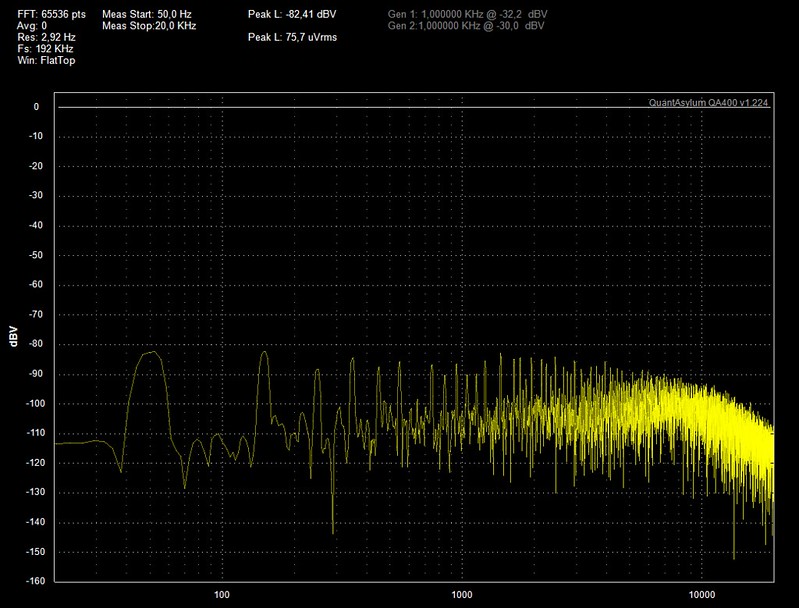
Not A-weighted, cartridge connected:
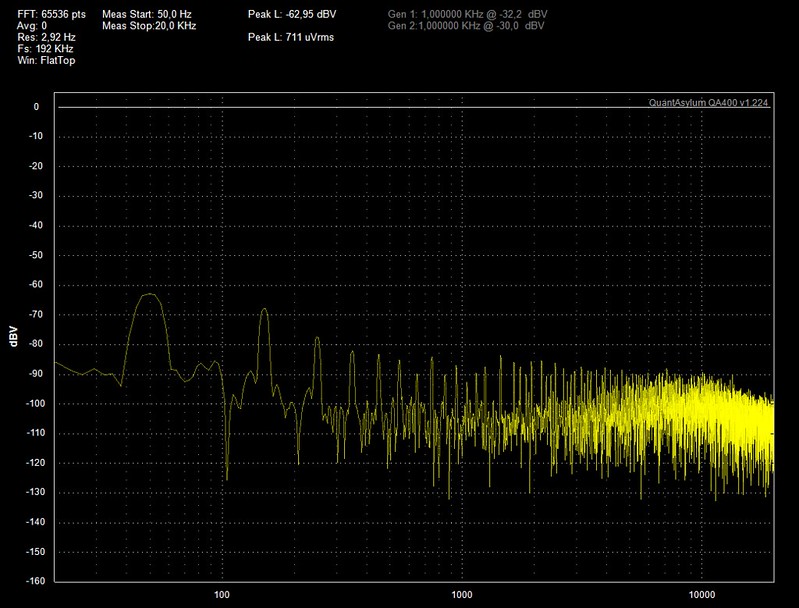
Wanting to compare apples to apples, I saw one rather well known maker of hifi equipment showing their SNR-measurement with shorted input relative to 3V rms output. That's more than 11 dB over 0 dBV. Their phono stage has 36 dB gain, and an SNR at 80 dB, A-weighted, under these conditions.
I'm not trying to jack up the results, but I do want to find out how they stack up in a way that's comparable to the commercial offerings.
A-weighted, cartridge connected: 82.41 dB
Not A-weighted, cartridge connected: 62.95 dB
A-weighted, cartridge connected:

Not A-weighted, cartridge connected:

Wanting to compare apples to apples, I saw one rather well known maker of hifi equipment showing their SNR-measurement with shorted input relative to 3V rms output. That's more than 11 dB over 0 dBV. Their phono stage has 36 dB gain, and an SNR at 80 dB, A-weighted, under these conditions.
I'm not trying to jack up the results, but I do want to find out how they stack up in a way that's comparable to the commercial offerings.
The QA400 picks up 50 Hz distortion (same 50 Hz bump with no cables attached to it), I moved it to try to eliminate it. It didn't go away completely, but it improved.
The gain is still 46 dB. The turntable is connected to the preamp, but it's not spinning. The cartridge is an Ortofon 2M Blue.
A-weighted, cartridge connected: 87.99 dB
Not A-weighted, cartridge connected: 70.30 dB
A-weighted, cartridge connected:
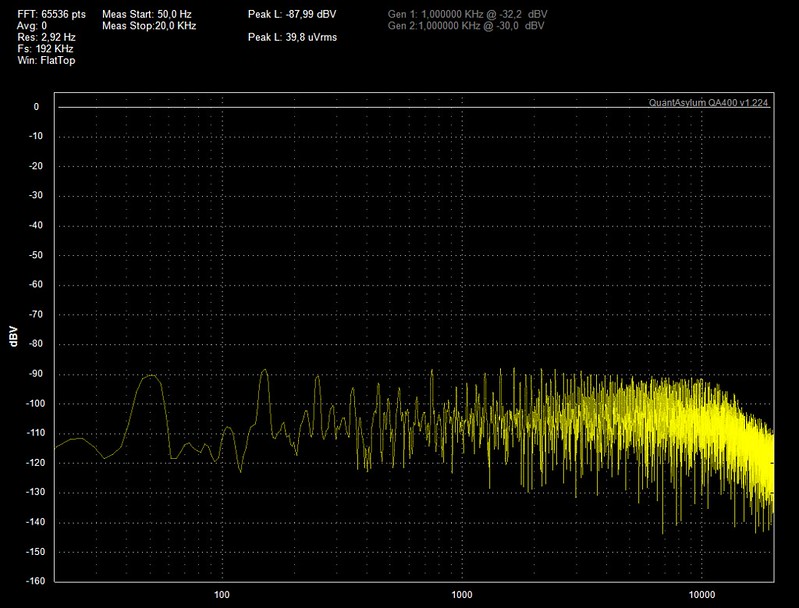
Not A-weighted, cartridge connected:
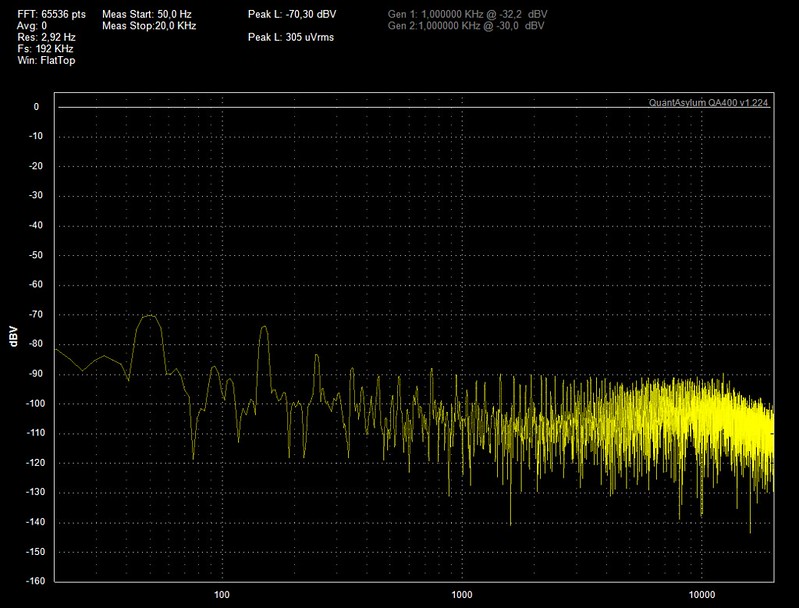
The gain is still 46 dB. The turntable is connected to the preamp, but it's not spinning. The cartridge is an Ortofon 2M Blue.
A-weighted, cartridge connected: 87.99 dB
Not A-weighted, cartridge connected: 70.30 dB
A-weighted, cartridge connected:

Not A-weighted, cartridge connected:

Hi Skrodahl,
I'm on holiday, so I missed your earlier postings.
Can you please do the same as posting #47.
Offer a 1kHz signal to the input, until the output gives 1V rms
Make a note what the rms level of this 1kHz input signal is, let's say that this is X mv rms. Then calculate Z = 20log(X/5)
Then shorten the input and measure the A weighted noise in dBV, assume this is Y dB.
A weighted S/N in dB ref 5mV will then be Y+ Z.
And could you please show both graphs for measuring X and Y.
Be sure inputs are set for measurements in dBV and not dBU or dBR.
Hans
I'm on holiday, so I missed your earlier postings.
Can you please do the same as posting #47.
Offer a 1kHz signal to the input, until the output gives 1V rms
Make a note what the rms level of this 1kHz input signal is, let's say that this is X mv rms. Then calculate Z = 20log(X/5)
Then shorten the input and measure the A weighted noise in dBV, assume this is Y dB.
A weighted S/N in dB ref 5mV will then be Y+ Z.
And could you please show both graphs for measuring X and Y.
Be sure inputs are set for measurements in dBV and not dBU or dBR.
Hans
It was adopted from the original CNC circuit, and I supposed it was a current limiting resistor that would limit higher than normal input levels like needle drop and such.
We had this very same discussion over at another forum, so I built this one with 300R input resistors instead. With shorted inputs the 2k2 and 300R versions measure about the same though.
I'll try to find the time to do the measurements you suggested soon.
Thanks for all your valuable help
We had this very same discussion over at another forum, so I built this one with 300R input resistors instead. With shorted inputs the 2k2 and 300R versions measure about the same though.
I'll try to find the time to do the measurements you suggested soon.
Thanks for all your valuable help
Last edited:
Hi Skrodahl, there are several things to be commented on.
First of all my own mistake, it should be Y - Z instead of Y + Z, sorry fot that.
Needing 6.7mV to get 1Volt, means 43.5 dB gain at 1kHz.
But, noise should be following the RIAA curve, which it does not. So I am a bit suspicious wether the lower part of the RIAA curve is working correctly, being the 50Hz and the 500Hz time constants.
So please check the gain at 50 Hz, it should be ca. 60 dB.
The 2 kHz time constant seems to be effective.
Last but not least, you are using the peak noise level of 100.3dB, but it should be the cumulated noise from 20Hz to 20kHz.
This seems to be the biggest error of them all.
So going back to posting #47, what exactly did you do there. Above the graph one could read 79.9dB, which seems about right.
Regards,
Hans
First of all my own mistake, it should be Y - Z instead of Y + Z, sorry fot that.
Needing 6.7mV to get 1Volt, means 43.5 dB gain at 1kHz.
But, noise should be following the RIAA curve, which it does not. So I am a bit suspicious wether the lower part of the RIAA curve is working correctly, being the 50Hz and the 500Hz time constants.
So please check the gain at 50 Hz, it should be ca. 60 dB.
The 2 kHz time constant seems to be effective.
Last but not least, you are using the peak noise level of 100.3dB, but it should be the cumulated noise from 20Hz to 20kHz.
This seems to be the biggest error of them all.
So going back to posting #47, what exactly did you do there. Above the graph one could read 79.9dB, which seems about right.
Regards,
Hans
Last edited:
I had turned A-weighting on for both measurements, so I turned it off for all the measurements in this post. Here's the 1 kHz without A-weighting:
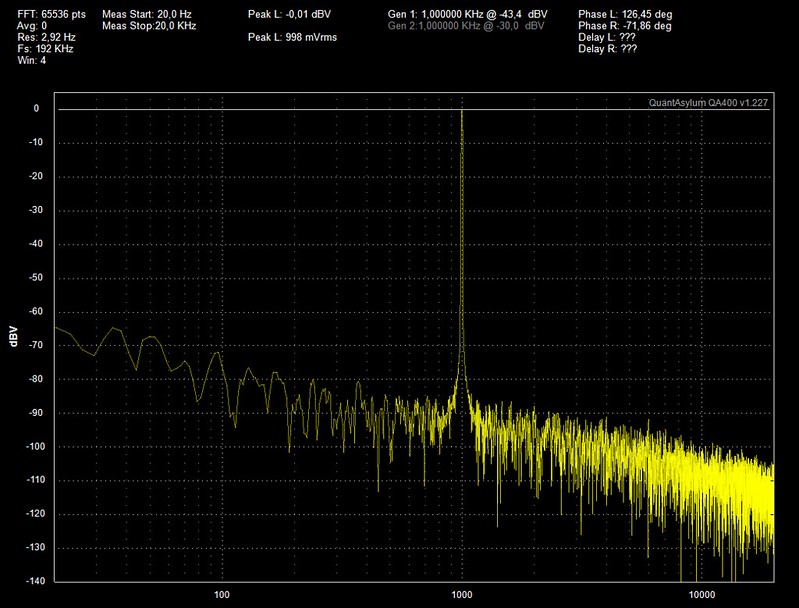 [/url]
[/url]
Here's the frequency response:
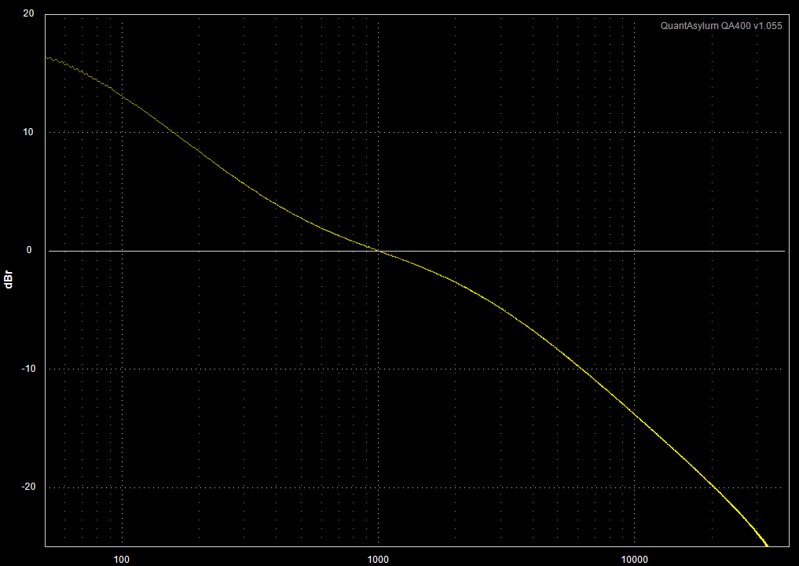
The QA400 signal generator creates sort of a burst signal, so I hooked up a Rigol DG1022 instead, and got really crazy results. So I connected the Rigol to the QA400 directly. Here's the 1 kHz/1 Vrms signal from the Rigol:
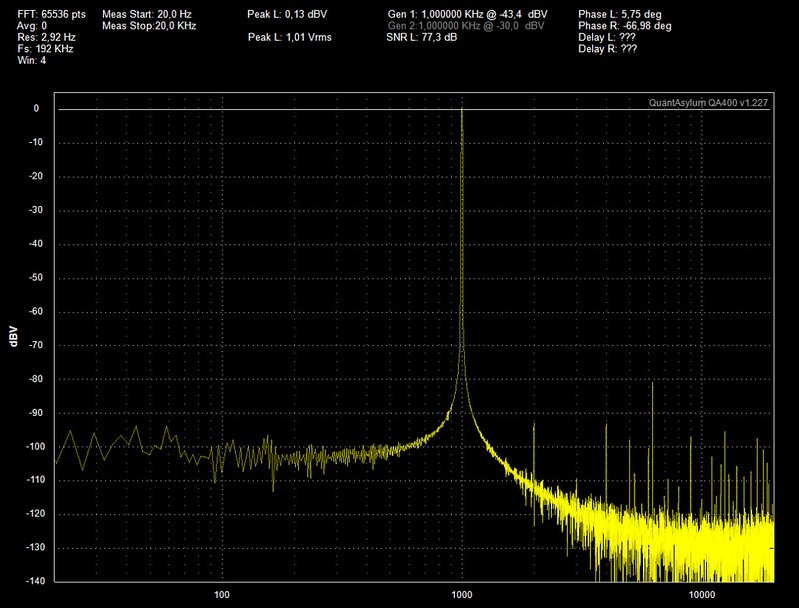
A lot of peaks in the higher frequencies that aren't present when the QA400 generates the signal, that show up when the smaller signal is sent through the preamp. Frequencies below 2 kHz look very similar to the very first graph in this post though:
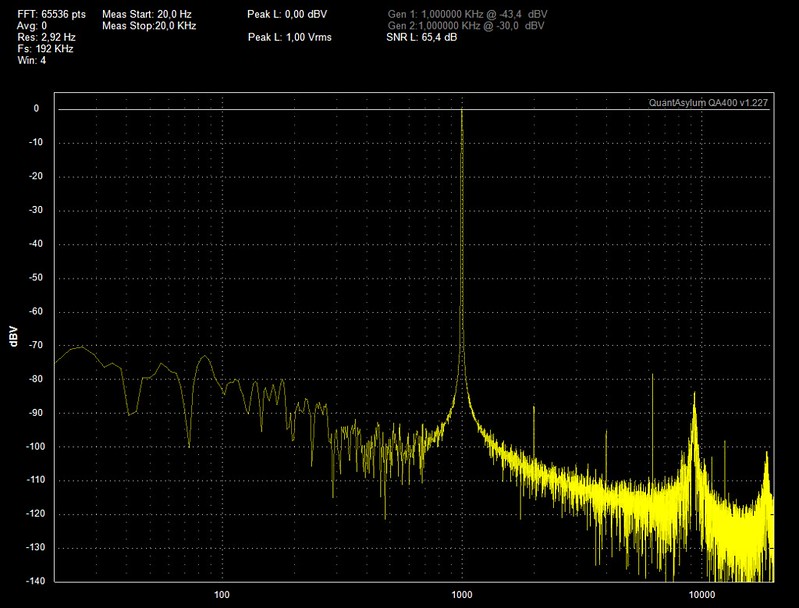
Here's that last measurement A-weighted:

I might not be able to get good enough measurements...

Here's the frequency response:

The QA400 signal generator creates sort of a burst signal, so I hooked up a Rigol DG1022 instead, and got really crazy results. So I connected the Rigol to the QA400 directly. Here's the 1 kHz/1 Vrms signal from the Rigol:

A lot of peaks in the higher frequencies that aren't present when the QA400 generates the signal, that show up when the smaller signal is sent through the preamp. Frequencies below 2 kHz look very similar to the very first graph in this post though:

Here's that last measurement A-weighted:

I might not be able to get good enough measurements...
So you said it was wrong to use the peak noise value. Here's a measurement, A-weighted as you specified, that shows the total power of the output (which is the total power of the noise, since there is no signal) when the input is shorted:
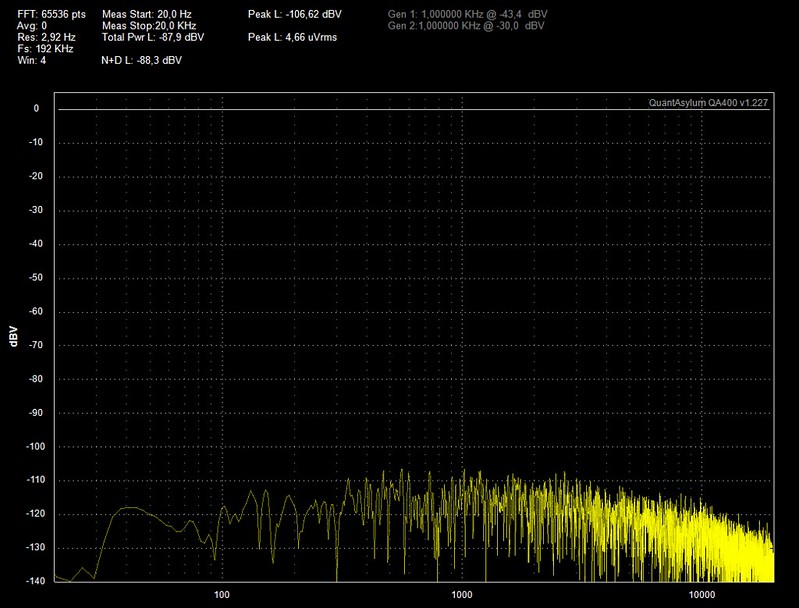 [/url]
[/url]
The total power of the output is -87.9 dBV.
Would "87.9 - 2.54 = 85.36" be closer to an answer?
Here's the same graph, without A-weighting for reference:
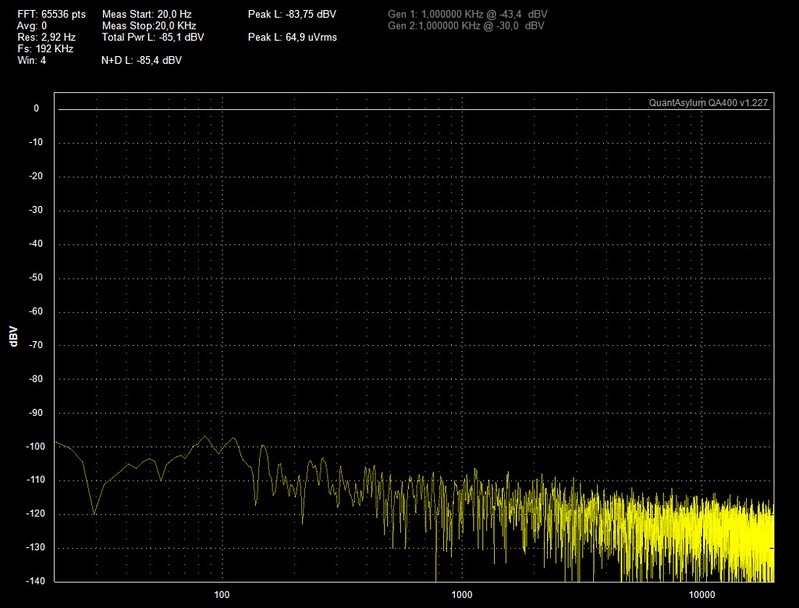

The total power of the output is -87.9 dBV.
Would "87.9 - 2.54 = 85.36" be closer to an answer?
Here's the same graph, without A-weighting for reference:

Last edited:
Hi,
Now we are moving in the right direction. I haven't much time untill tonight, but I have two questions.
You have measured the 6.7mV with A-weighting on, can you repeat this measurement with A-weighting off, because that is the correct way.
And can you also measure total noise power A-weighted with the input shorted and also the 2.2k at the input shorted.
Regards
Hans
Now we are moving in the right direction. I haven't much time untill tonight, but I have two questions.
You have measured the 6.7mV with A-weighting on, can you repeat this measurement with A-weighting off, because that is the correct way.
And can you also measure total noise power A-weighted with the input shorted and also the 2.2k at the input shorted.
Regards
Hans
I kind of went overboard with the graphs, but I did do those as well.
Here's the 6.7mV with a-weighting off:

Here's the total noise power, A-weighted, with the input shorted (300R input resistor):

I don't have a phono stage with 2k2 input resistors on hand, so I'll not be able to do that measurement atm.
Thanks again for your excellent help.
Here's the 6.7mV with a-weighting off:

Here's the total noise power, A-weighted, with the input shorted (300R input resistor):

I don't have a phono stage with 2k2 input resistors on hand, so I'll not be able to do that measurement atm.
Thanks again for your excellent help.
Hi Skrodahl.
Good that you have replaced the 2k2 by 300 ohm, it could just as well be 100 ohm, but 300 Ohm adds insignificant noise. 2k2 is out of the question.
Applying the rule of thumb again, results in less noise, but also less signal, so this figure remains at -80.3 dB.
Your measurements are pointing in the direction of +5dB, which is substantial.
This would implicate that you have an excellent opa2134.
There are still a few things that are a bit unexpexted, but that may be accounted to the equipment used for measuring which will have some error margin.
I can imagine you are fed up with measuring, so let's call it a day and stop with it.
At the end the 85dB is not too significant, since the cartridge and the 47k input resistor will take their share and bring this figure down considerably.
Regards
Hans
Good that you have replaced the 2k2 by 300 ohm, it could just as well be 100 ohm, but 300 Ohm adds insignificant noise. 2k2 is out of the question.
Applying the rule of thumb again, results in less noise, but also less signal, so this figure remains at -80.3 dB.
Your measurements are pointing in the direction of +5dB, which is substantial.
This would implicate that you have an excellent opa2134.
There are still a few things that are a bit unexpexted, but that may be accounted to the equipment used for measuring which will have some error margin.
I can imagine you are fed up with measuring, so let's call it a day and stop with it.
At the end the 85dB is not too significant, since the cartridge and the 47k input resistor will take their share and bring this figure down considerably.
Regards
Hans
I did some simulations with your circuit diagram with a FET Op-Amp, the LTC 6244HV, having exactly the same 8nV/rtHz as the OPA2134, just because the latter is not available in LTSpice.
Two noise simulations with
1) shorted input and
2) with an element having 600Ohm / 500mH plus a 47K input resistor and a simulated input cable with (an optimal) 150pF capacitance, gave the following A-weighted noise spectra
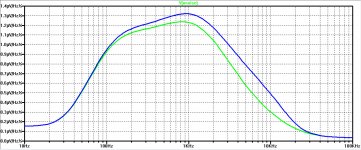
The total A-weighted noise power for 1) and 2) where resp. 76.4uV and 94.1uV.
I measured in the simulation the same 42.3dB gain as you did, giving a SNR ref. 5mV@1kHz of resp 79dB and 77dB for 1) and 2)
This 79dB is much closer to the predicted 80dB, but 6dB apart from your measurement.
So I'm still thinking that something in your measuring equipment is not properly calibrated.
Nevertheless, these figures are still excellent.
Hans
Two noise simulations with
1) shorted input and
2) with an element having 600Ohm / 500mH plus a 47K input resistor and a simulated input cable with (an optimal) 150pF capacitance, gave the following A-weighted noise spectra

The total A-weighted noise power for 1) and 2) where resp. 76.4uV and 94.1uV.
I measured in the simulation the same 42.3dB gain as you did, giving a SNR ref. 5mV@1kHz of resp 79dB and 77dB for 1) and 2)
This 79dB is much closer to the predicted 80dB, but 6dB apart from your measurement.
So I'm still thinking that something in your measuring equipment is not properly calibrated.
Nevertheless, these figures are still excellent.
Hans
- Status
- This old topic is closed. If you want to reopen this topic, contact a moderator using the "Report Post" button.
- Home
- Source & Line
- Analogue Source
- AK phonostage
